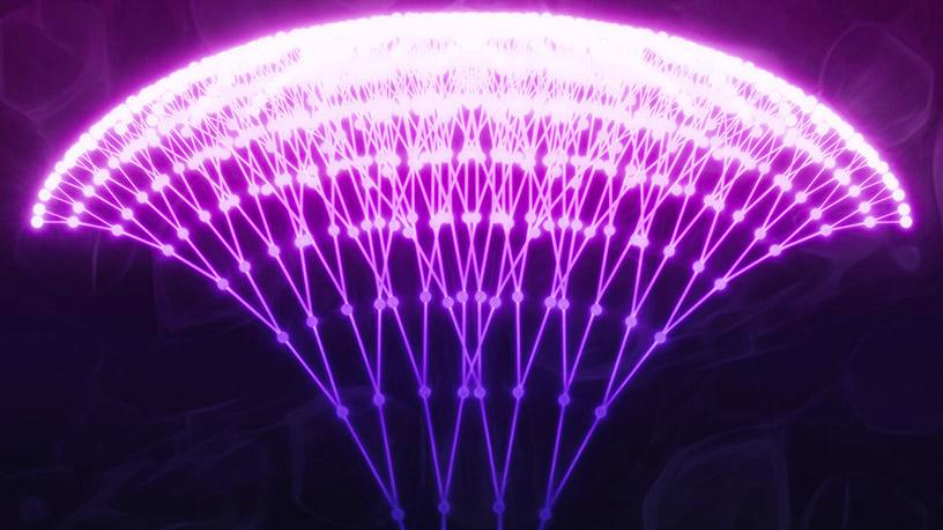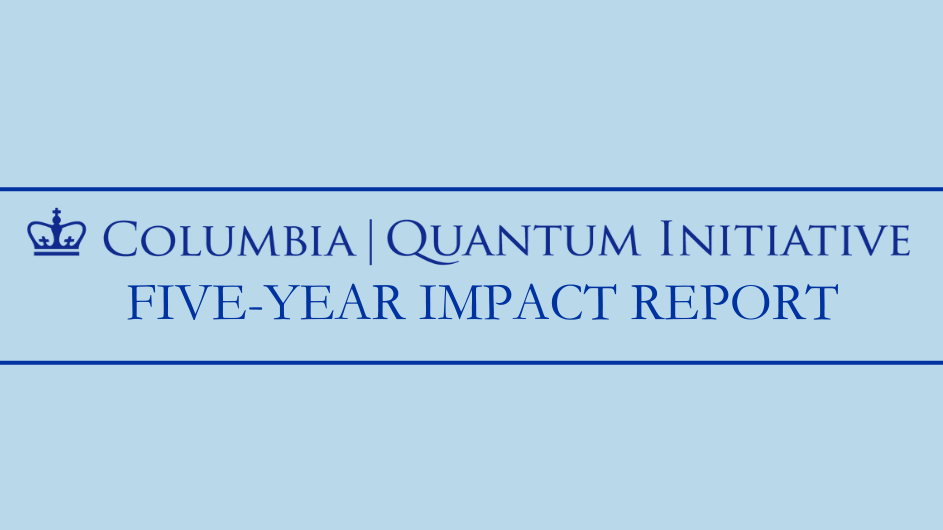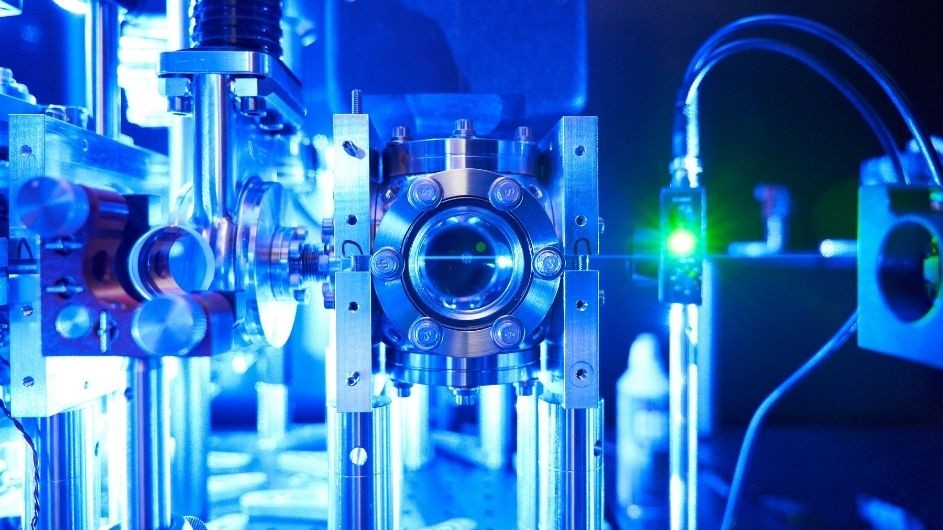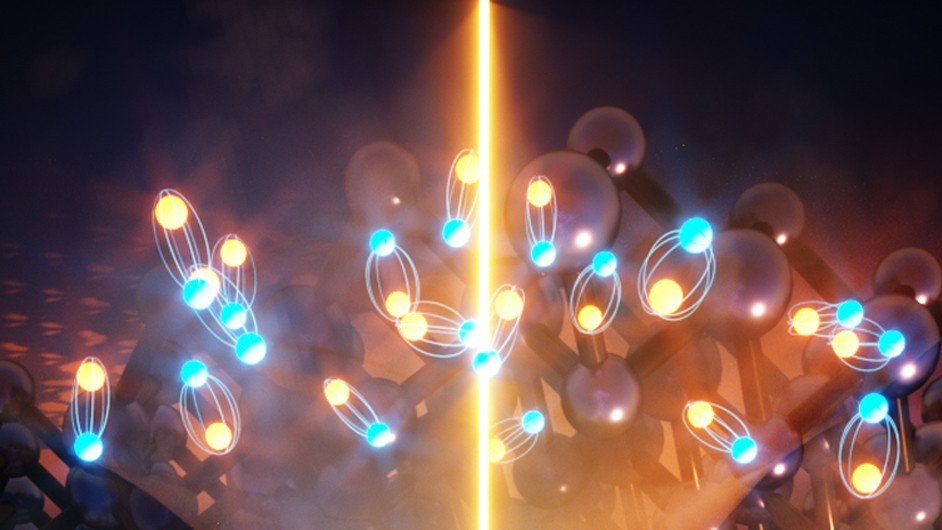A Look Back At Our First Five Years
Highlights since the Columbia Quantum Initiative came together in 2018.
To view and save a PDF version of this report, click here.
A Note From Quantum Task Force Co-Leads, Dmitri Basov & Alexander Gaeta:
Five years ago, research groups from across Columbia came together as the Columbia Quantum Initiative to combine our strengths in quantum fundamentals, quantum materials, and quantum optics. Our goal is to lay foundations for the second quantum revolution while teaching the next generation of quantum scientists. Here, we celebrate our first five years of achievements in quantum research and education.
Since 2018, we have...
- Welcomed seven new hires to our 29 core quantum faculty.

- Mentored over 80 postdoctoral fellows and 160 graduate students, with alumni now holding academic, government, and industry positions around the world.
- Exposed hundreds of students from Columbia, Barnard, and those elected to undergraduate research experience programs to the latest quantum research.
- Published more than 500 senior-author research papers, and over 500 more as contributing authors.
More About Our Papers
- Authors
- Meirzadeh et al.
- Title
- A few-layer covalent network of fullerenes
- Year
- 2023
- Journal
- Nature
- Cited by
- 28
- Authors
- Jindal et al.
- Title
- Coupled ferroelectricity and superconductivity in bilayer Td-MoTe2
- Year
- 2023
- Journal
- Nature
- Cited by
- 26
- Authors
- Sternbach et al.
- Title
- Negative refraction in hyperbolic hetero-bicrystals
- Year
- 2023
- Journal
- Science
- Cited by
- 9
- Authors
- Lee et al.
- Title
- Indefinite and bidirectional near-infrared nanocrystal photoswitching
- Year
- 2023
- Journal
- Nature
- Cited by
- 3
- Authors
- Kapfer et al.
- Title
- Programming twist angle and strain profiles in 2D materials
- Year
- 2023
- Journal
- Science
- Cited by
- 2
- Authors
- Zhao et al.
- Title
- Smectic pair-density-wave order in EuRbFe4As4
- Year
- 2023
- Journal
- Nature
- Cited by
- 1
- Authors
- Will S., Zelevinsky T.
- Title
- Ultracold molecules find the sweet spot for collisions
- Year
- 2023
- Journal
- Nature
- Cited by
- Authors
- 1. Yankowitz et al.
- Title
- Tuning superconductivity in twisted bilayer graphene
- Year
- 2019
- Journal
- Science
- Cited by
- 1311
- DOI
- Authors
- 2. Kippenberg et al.
- Title
- Dissipative Kerr solitons in optical microresonators
- Year
- 2018
- Journal
- Science
- Cited by
- 1072
- DOI
- Authors
- 3. Mandal et al.
- Title
- Hierarchically porous polymer coatings for highly efficient passive daytime radiative cooling
- Year
- 2018
- Journal
- Science
- Cited by
- 959
- DOI
- Authors
- 4. Fei et al.
- Title
- Two-dimensional itinerant ferromagnetism in atomically thin Fe3GeTe2
- Year
- 2018
- Journal
- Nature Materials
- Cited by
- 852
- DOI
- Authors
- 5. Sun et al.
- Title
- PySCF: the Python-based simulations of chemistry framework
- Year
- 2018
- Journal
- Wiley Interdisciplinary Reviews: Computational Molecular Science
- Cited by
- 779
- DOI
- Authors
- 6. Gaeta et al.
- Title
- Photonic-chip-based frequency combs
- Year
- 2019
- Journal
- Nature Photonics
- Cited by
- 605
- DOI
- Authors
- 7. Kerelsky et al.
- Title
- Maximized electron interactions at the magic angle in twisted bilayer graphene
- Year
- 2019
- Journal
- Nature
- Cited by
- 580
- DOI
- Authors
- 8. Roos et al.
- Title
- OPLS3e: Extending Force Field Coverage for Drug-Like Small Molecules
- Year
- 2019
- Journal
- Journal of Chemical Theory and Computation
- Cited by
- 570
- DOI
- Authors
- 9. Fu et al.
- Title
- Metal halide perovskite nanostructures for optoelectronic applications and the study of physical properties
- Year
- 2019
- Journal
- Nature Reviews Materials
- Cited by
- 546
- DOI
- Authors
- 10. Wang et al.
- Title
- Correlated electronic phases in twisted bilayer transition metal dichalcogenides
- Year
- 2020
- Journal
- Nature Materials
- Cited by
- 458
- DOI
- Authors
- 11. Wang et al.
- Title
- Nanophotonic lithium niobate electro-optic modulators
- Year
- 2018
- Journal
- Optics Express
- Cited by
- 443
- DOI
- Authors
- 12. Stern et al.
- Title
- Battery-operated integrated frequency comb generator
- Year
- 2018
- Journal
- Nature
- Cited by
- 439
- DOI
- Authors
- 13. Caldwell et al.
- Title
- Photonics with hexagonal boron nitride
- Year
- 2019
- Journal
- Nature Reviews Materials
- Cited by
- 433
- DOI
- Authors
- 14. McIver et al.
- Title
- Light-induced anomalous Hall effect in graphene
- Year
- 2020
- Journal
- Nature Physics
- Cited by
- 430
- DOI
- Authors
- 15. Shrestha et al.
- Title
- Broadband achromatic dielectric metalenses
- Year
- 2018
- Journal
- Light: Science and Applications
- Cited by
- 421
- DOI
- Authors
- 16. Lu et al.
- Title
- OPLS4: Improving force field accuracy on challenging regimes of chemical space
- Year
- 2021
- Journal
- Journal of Chemical Theory and Computation
- Cited by
- 383
- DOI
- Authors
- 17. Ni et al.
- Title
- Fundamental limits to graphene plasmonics
- Year
- 2018
- Journal
- Nature
- Cited by
- 374
- DOI
- Authors
- 18. Balents et al.
- Title
- Superconductivity and strong correlations in moiré flat bands
- Year
- 2020
- Journal
- Nature Physics
- Cited by
- 359
- DOI
- Authors
- 19. Rhodes et al.
- Title
- Disorder in van der Waals heterostructures of 2D materials
- Year
- 2019
- Journal
- Nature Materials
- Cited by
- 342
- DOI
- Authors
- 20. Ribeiro-Palau et al.
- Title
- Twistable electronics with dynamically rotatable heterostructures
- Year
- 2018
- Journal
- Science
- Cited by
- 326
- DOI
- Authors
- 21. Song et al.
- Title
- Switching 2D magnetic states via pressure tuning of layer stacking
- Year
- 2019
- Journal
- Nature Materials
- Cited by
- 307
- DOI
- Authors
- 22. Wang et al.
- Title
- Evidence of high-temperature exciton condensation in two-dimensional atomic double layers
- Year
- 2019
- Journal
- Nature
- Cited by
- 285
- DOI
- Authors
- 23. Sun et al.
- Title
- Recent developments in the P y SCF program package
- Year
- 2020
- Journal
- Journal of Chemical Physics
- Cited by
- 289
- DOI
- Authors
- 24. Sie et al.
- Title
- An ultrafast symmetry switch in a Weyl semimetal
- Year
- 2019
- Journal
- Nature
- Cited by
- 267
- DOI
- Authors
- 25. Giles et al.
- Title
- Ultralow-loss polaritons in isotopically pure boron nitride
- Year
- 2018
- Journal
- Nature Materials
- Cited by
- 262
- DOI
- Authors
- 26. Zondiner et al.
- Title
- Cascade of phase transitions and Dirac revivals in magic-angle graphene
- Year
- 2020
- Journal
- Nature
- Cited by
- 258
- DOI
- Authors
- 27.Overvig et al.
- Title
- Dielectric metasurfaces for complete and independent control of the optical amplitude and phase
- Year
- 2019
- Journal
- Light: Science and Applications
- Cited by
- 258
- DOI
- Authors
- 28. Miyata et al.
- Title
- Triplet Pair States in Singlet Fission
- Year
- 2019
- Journal
- Chemical Reviews
- Cited by
- 249
- DOI
- Authors
- 29. Sunku et al.
- Title
- Photonic crystals for nano-light in moiré graphene superlattices
- Year
- 2018
- Journal
- Science
- Cited by
- 248
- DOI
- Authors
- 30. Dutt et al.
- Title
- On-chip dual-comb source for spectroscopy
- Year
- 2018
- Journal
- Science Advances
- Cited by
- 246
- DOI
- Authors
- 31. Xu et al.
- Title
- Correlated insulating states at fractional fillings of moiré superlattices
- Year
- 2020
- Journal
- Nature
- Cited by
- 246
- DOI
- Authors
- 32. Yu et al.
- Title
- Silicon-chip-based mid-infrared dual-comb spectroscopy
- Year
- 2018
- Journal
- Nature Communications
- Cited by
- 242
- DOI
- Authors
- 33. Kennes et al.
- Title
- Moiré heterostructures as a condensed-matter quantum simulator
- Year
- 2021
- Journal
- Nature Physics
- Cited by
- 236
- DOI
- Authors
- 34. Liu et al.
- Title
- Disassembling 2D van der Waals crystals into macroscopic monolayers and reassembling into artificial lattices
- Year
- 2020
- Journal
- Science
- Cited by
- 223
- DOI
- Authors
- 35. Polshyn et al.
- Title
- Large linear-in-temperature resistivity in twisted bilayer graphene
- Year
- 2019
- Journal
- Nature Physics
- Cited by
- 222
- DOI
- Authors
- 36. Kunstmann et al.
- Title
- Momentum-space indirect interlayer excitons in transition-metal dichalcogenide van der Waals heterostructures
- Year
- 2018
- Journal
- Nature Physics
- Cited by
- 216
- DOI
- Authors
- 37. Egger et al.
- Title
- What Remains Unexplained about the Properties of Halide Perovskites?
- Year
- 2018
- Journal
- Advanced Materials
- Cited by
- 212
- DOI
- Authors
- 38. Garner et al.
- Title
- Comprehensive suppression of single-molecule conductance using destructive σ-interference
- Year
- 2018
- Journal
- Nature
- Cited by
- 210
- DOI
- Authors
- 39. Raja et al.
- Title
- Dielectric disorder in two-dimensional materials
- Year
- 2019
- Journal
- Nature Nanotechnology
- Cited by
- 208
- DOI
- Authors
- 40. Yankowitz et al.
- Title
- Dynamic band-structure tuning of graphene moiré superlattices with pressure
- Year
- 2018
- Journal
- Nature
- Cited by
- 203
- DOI
- Authors
- 41. Mandal et al.
- Title
- Paints as a Scalable and Effective Radiative Cooling Technology for Buildings
- Year
- 2020
- Journal
- Joule
- Cited by
- 201
- DOI
- Authors
- 42. Miller et al.
- Title
- Large-scale optical phased array using a low-power multi-pass silicon photonic platform
- Year
- 2020
- Journal
- Optica
- Cited by
- 200
- DOI
- Authors
- 43. Garfield et al.
- Title
- Enrichment of molecular antenna triplets amplifies upconverting nanoparticle emission
- Year
- 2018
- Journal
- Nature Photonics
- Cited by
- 185
- DOI
- Authors
- 44. Fernandez-Bravo et al.
- Title
- Continuous-wave upconverting nanoparticle microlasers
- Year
- 2018
- Journal
- Nature Nanotechnology
- Cited by
- 181
- DOI
- Authors
- 45. Chen et al.
- Title
- Modern Scattering-Type Scanning Near-Field Optical Microscopy for Advanced Material Research
- Year
- 2019
- Journal
- Advanced Materials
- Cited by
- 176
- DOI
- Authors
- 46. Luo et al.
- Title
- Deterministic coupling of site-controlled quantum emitters in monolayer WSe2 to plasmonic nanocavities
- Year
- 2018
- Journal
- Nature Nanotechnology
- Cited by
- 164
- DOI
- Authors
- 47. McGilly et al.
- Title
- Visualization of moiré superlattices
- Year
- 2020
- Journal
- Nature Nanotechnology
- Cited by
- 161
- DOI
- Authors
- 48. Evans et al.
- Title
- Continuous-Wave Lasing in Cesium Lead Bromide Perovskite Nanowires
- Year
- 2018
- Journal
- Advanced Optical Materials
- Cited by
- 159
- DOI
- Authors
- 49. Inkpen et al.
- Title
- Non-chemisorbed gold–sulfur binding prevails in self-assembled monolayers
- Year
- 2019
- Journal
- Nature Chemistry
- Cited by
- 153
- DOI
- Authors
- 50. Huang et al.
- Title
- Electrophotocatalysis with a Trisaminocyclopropenium Radical Dication
- Year
- 2019
- Journal
- Angewandte Chemie - International Edition
- Cited by
- 152
- DOI
- Were awarded nearly $150 million in grants, including for the establishment of two flagship quantum centers: the Department of Energy (DOE)-Funded EFRC on Programmable Quantum Materials and the National Science Foundation (NSF)-Funded MRSEC on Precision-Assembled Quantum Materials.
- Celebrated our faculty who received over two dozen awards and honors, including multiple NSF Career Awards; NSF PECASE Awards; DOE Early Career Awards; Vannevar Bush Awards; Moore Awards; Brown Science Awards; Sloan Fellowships; and inductions to the National Academy of Sciences.
FIVE-YEAR HIGHLIGHTS
Columbia Launches Master’s in Quantum Science and Technology | The degree program will combine education in quantum fundamentals with hands-on experience in quantum research labs
Quantum Leaps and Bounds | Columbia University joins the Flatiron Institute and Germany’s Max Planck Society for the Advancement of Science to establish the Max Planck - New York City Center for Nonequilibrium Quantum Phenomena
Switching Nanolight On and Off | A team of researchers led by Columbia University has developed a unique platform to program a layered crystal, producing imaging capabilities beyond common limits on demand.
Columbia Chemists Discover a New Form of Carbon: Graphene’s “Superatomic” Cousin | Graphullerene, an atom-thin material made of linked fullerene subunits, gives scientists a new form of modular carbon to play with.
Scientists See Spins in a 2D Magnet | Research shows that spinning quasiparticles, or magnons, light up when paired with a light-emitting quasiparticle, or exciton, with potential quantum information applications.

Columbia Engineers First to Observe Avalanches in Nanoparticles | Researchers develop the first nanomaterial that demonstrates "photon avalanching." The finding could lead to new applications in sensing, imaging, and light detection.
A Superatomic Semiconductor Sets a Speed Record | Columbia chemists discover ballistic flow in a quantum material. The finding could help overcome shortcomings in semiconductors.
Ribbons of Graphene Push the Material’s Potential | A new technique developed at Columbia may help physicists better probe the fundamental properties of 2Dmaterials.



